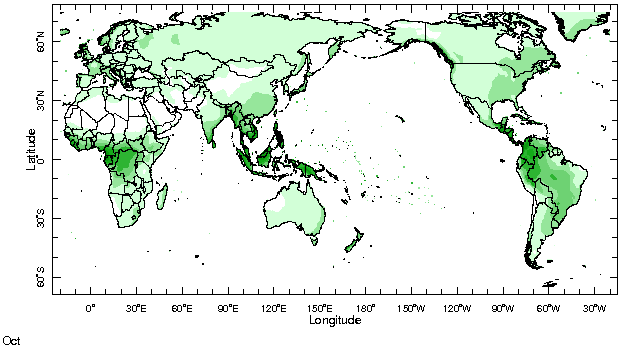|
IRI Climate Digest
November 2003
October Global Climate Summary
Climatological Background
During October, the Northern Hemisphere mid-latitude storm tracks increase in strength, while monsoon systems in West Africa, South Asia, and southwestern North America continue their retreat southward following the maximum solar heating. Late season tropical storm activity continues in the North Atlantic, the North Pacific and northern Indian Oceans. Spring is underway in the Southern Hemisphere, with mid-latitude storm tracks losing strength.
Monthly Mean Temperature (1961-1990), data from the Climate Research
Unit, University of East Anglia


Monthly Mean Precipitation (1961-1990), data from the Climate Research
Unit, University of East Anglia


Temperatures
Highlights
Above-average temperatures brought relief to northern Europe after a scorching summer, while unseasonably warm conditions persisted across much of Asia, Alaska and northern Canada. The western United States and Central Asia also experienced above-average temperatures in October, as did much of South America and Africa. Southeastern Australia was one of the two regions in which cooler-than-average conditions were observed.
Temperature Difference from the 1961-1990 mean, with data
from NCEP Climate Prediction Center, CAMS.


Precipitation
Highlights
As the Northern Hemisphere monsoons retreat southwards the rainy seasons revive in East Africa, southern peninsular India and Sri Lanka, Malaysia, and Central America. East Africa: Although parts of Kenya and southern Somalia received ample early rains, southern Ethiopia, Somalia, Uganda, Rwanda and northern Tanzania experienced deficits at the start of the short rains.
South Asia: Above-normal rain fell in southeastern India and Sri Lanka to begin the northwest monsoon.
Maritime Continent: Indonesia and Malaysia experienced wetter-than-average conditions in October.
Central America: While Mexico received excess rainfall resulting from 3 tropical storms during October, Central America received less-than-average rainfall.
Europe: In a change from previous months, relatively wet conditions developed over much of Europe, though England, and the Scandinavian peninsula continued to be dry.
South America: Precipitation amounts continued to be below normal in much of northern South America and deficits also persisted in southern Brazil. Wetter-than-average conditions continued in Ecuador and developed in the Altiplano of the Andes.
North America: Below-normal precipitation was observed in most of North America except the Northwest and British Columbia and the Northeast to Newfoundland.
Precipitation Difference from 1961-1990 mean, with data
from NCEP Climate Prediction Center, CAMS-OPI.


Oceanic Conditions
Tropical Pacific: The equatorial Pacific Ocean has developed slightly warmer-than-average sea surface temperatures across the basin, but they are still within the normal range and unlikely to develop further into El Niņo conditions. See the latest IRI ENSO Update for a detailed summary and outlook.
Tropical Atlantic: Sea surface temperatures remain slightly above normal throughout most of the northern tropical Atlantic Ocean. The largest temperature departures are just above 1°C along the Mauritanian and Moroccan coasts.
Indian Ocean: Temperatures continued to decrease in the tropical Indian Ocean, but the equatorial region remains 0.5-1.°C above normal.
Mid-latitudes: Conditions in the north Pacific Ocean cooled, but much of the basin remains warmer than average. Around Europe, ocean surface temperatures in the Mediterranean Sea, the North Sea, and the northeastern Atlantic continued to decrease, whereas temperatures increased in the waters between the Canadian maritime provinces and Greenland. The southern Indian and Atlantic Oceans warmed slightly in October, while the southern Pacific Ocean cooled from last month.
Monthly Sea Surface Temperature Difference from the 1971-2000 mean,
with data from the Environmental Modeling Center, NCEP/NOAA.


Contents |
Special |
Impacts |
Climate |
Forecast
|

